13.3 x 8.7 cm. Cecil Higgins Art Gallery, Bedford.
But how can a workman, a carpenter, a mason, or a weaver offer himself artistic pleasure? First of all, by creating artworks, respond the English. But to do so, it was not at all necessary that he become a painter or perform music. He must simply introduce an aesthetic element into his craft, the humble work with which he has been entrusted. Morris went on: “The development of the lower classes should not be gone about backwards, by giving the workmen museums and concerts, but by giving them back their primitive role, by striving to make homes, clothing, utensils, furniture, and all the tools of daily life both useful and beautiful for everyone. What is an artist, if not a worker who is determined, whatever happens, to produce exceptional work? And what is the decoration of furniture, of any object, if not an expression of the pleasure that the craftsman feels from succeeding in his work?”[40] Morris also wanted all working-class people to learn the basics of design, not the art of drawing strictly speaking, but the means towards this end; a general ability in practising the arts. If this is not sufficient for them to begin producing aesthetic designs, the artists themselves should also participate, unashamed to apply their genius to the curve of a chair-back or the decoration of a pan. This collaboration would profit both of them, for “the artist who does not know how to work with his hands ends up completely forgetting the characteristics of the matter that he is supposed to dominate and creates mediocre works, and the workman with no artistic ideal can only produce standardised goods.” This is the tradition of the heroic days of art. In the past, the same man provided the mind that conceived and directed, the arms that laboured, and the expert hand that chiselled, modelled or painted. Today, unfortunately, the different sorts of artists are as separate from one another as they are from the various other professions. “By this division of labour,” said Ruskin, “you ruin all the arts at once. The work of the Academician becomes mean and effeminate because he is not used to treat colour on a grand scale and in rough materials; and your manufactures become base, because no well-educated person sets hand to them. And therefore it is necessary to understand, not merely as a logical statement but as a practical necessity, that wherever beautiful colour is to be arranged, you need a Master of Painting; and wherever noble form is to be given, a Master of Sculpture.”[41]
This is what the English did in the Arts and Crafts movement, at whose exhibitions a craftsman signed his work just as a member of the Royal Academy signed his paintings. The most sensitive artists, the most subtle thinkers transform their dreams into carpet designs or hearth screens. Burne-Jones decorated glazed pans and pianos and painted mosaic tiles for churches. Herkomer designed elaborate decorations for plates. Walter Crane, Richmond, Holiday and twenty others devoted their rare talents to the most common work. Looking around the restaurant of the South Kensington museum, one finds that one is in the midst of enchanting décor by the great poet William Morris, surrounded by figures drawn by the great symbolist Burne-Jones, and that one is eating venison with redcurrant jelly or rhubarb pie!
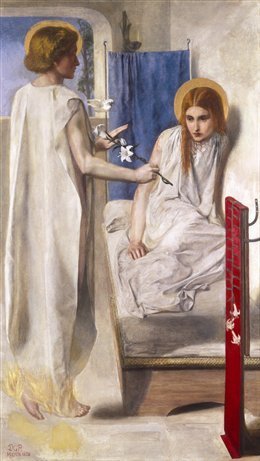
Dante Gabriel Rossetti, Ecce Ancilla Domini!
(The Annunciation), 1849-1850.
Oil on canvas, 72.4 x 41.9 cm.
Tate Britain, London.
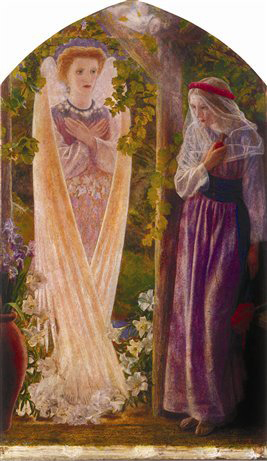
Arthur Hughes,
The Annunciation, 1872-1873.
Oil on canvas, 61.2 x 35.8 cm.
Birmingham Museums & Art Gallery, Birmingham.
If works of art were produced in this way by everyone, would they remain the privilege of a few, as paintings have? No, they must become the property of everyone. Only then can they truly achieve the status of useful works. “When you see delicate and harmonious colours and beautiful designs in the manufacture of windows; when you see pretty dresses in the streets expressing the beautiful forms of the women who wear them with the grace of flowers; when you feel a certain sense of balance and harmony in colour in the most common arrangements of paper and paint in your interiors; when your beds have gracious lines; when you find books on the table whose printers and illustrators considered them to be works of art as much as literature, and thus experience a double pleasure because they satisfy more than one of your senses, then you will begin to think that something has happened, that a new spirit has come upon the country to make such refinement possible for the common citizen, when before it would have been impossible.”[42]
If we still wish to use the designs of the great creators of palaces, paintings, and aristocratic pomp, may they at least be used in palaces which anyone may enter, in paintings that everyone can see, and in great popular exhibitions. This was Watts’ idea. It was also Ruskin’s, and he considered that the great works of the Middle Ages owe their existence and their splendour to this idea. “The first role of art was to express truth or beautify something useful. In the thirteenth century, art expressed a religion that souls were still able to understand, and decorated the buildings of citizens whose greatest happiness came from private honour and public magnificence. Public, because their ways were simple. Monuments that served the people as a whole were constructed by the painters, sculptors, jewellers, blacksmiths, embroiderers, and carpenters who composed, along with the merchants, a large third estate. At this time, they constructed the walls of Milan, the Naviglio Grande canal that carries water thirty miles from Tessin to Milan, the two storage facilities at Genoa, the walls on their banks, and their aqueducts. These immense public works employed legions of workmen and artists, who in those days were not distinct groups, as every artisan was a bit of an artist. They were paid reasonably and worked nobly for the city as best they could.”[43] When it is seen in this way, art will truly moralise the people, because it will no longer be something outside their lives, that happens above them like diplomacy, without demanding anything from them and without giving them any pleasure. It will moralise them because it will ennoble common, daily work, thereby “bringing the workman hope and pleasure in the place of fear and pain.” It will finally become “an art made by the people, and for the people, as happiness to the maker and the user.”[44]
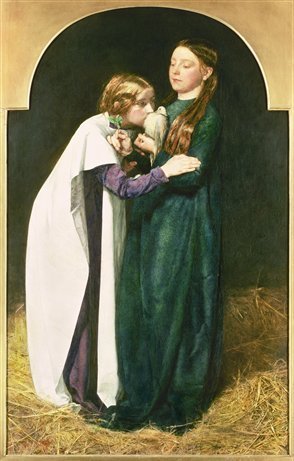
John Everett Millais,
The Return of the Dove to the Ark, 1851.
Oil on canvas, 88.2 x 54.9 cm.
The Ashmolean Museum of Art and Archaeology,
University of Oxford, Oxford.
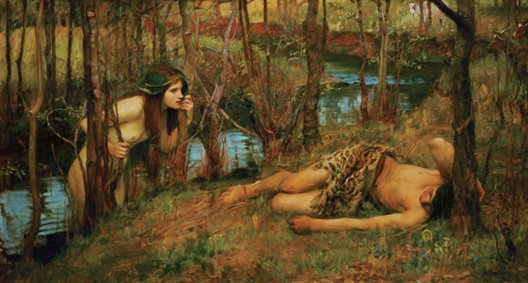
John William Waterhouse,
A Naiad (Hylas and a Water-Nymph), 1893.
Oil on canvas. Roy Miles Fine Paintings, London.
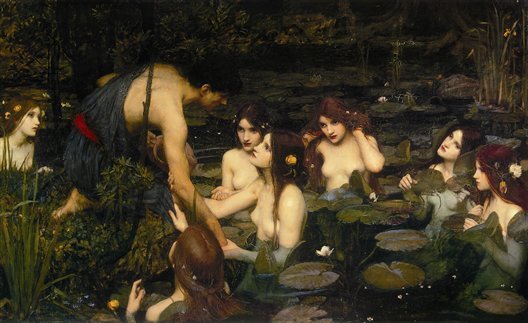
John William Waterhouse,
Hylas and the Nymphs, 1896.
Oil on canvas, 132.1 x 197.5 cm.
Manchester Art Gallery, Manchester.